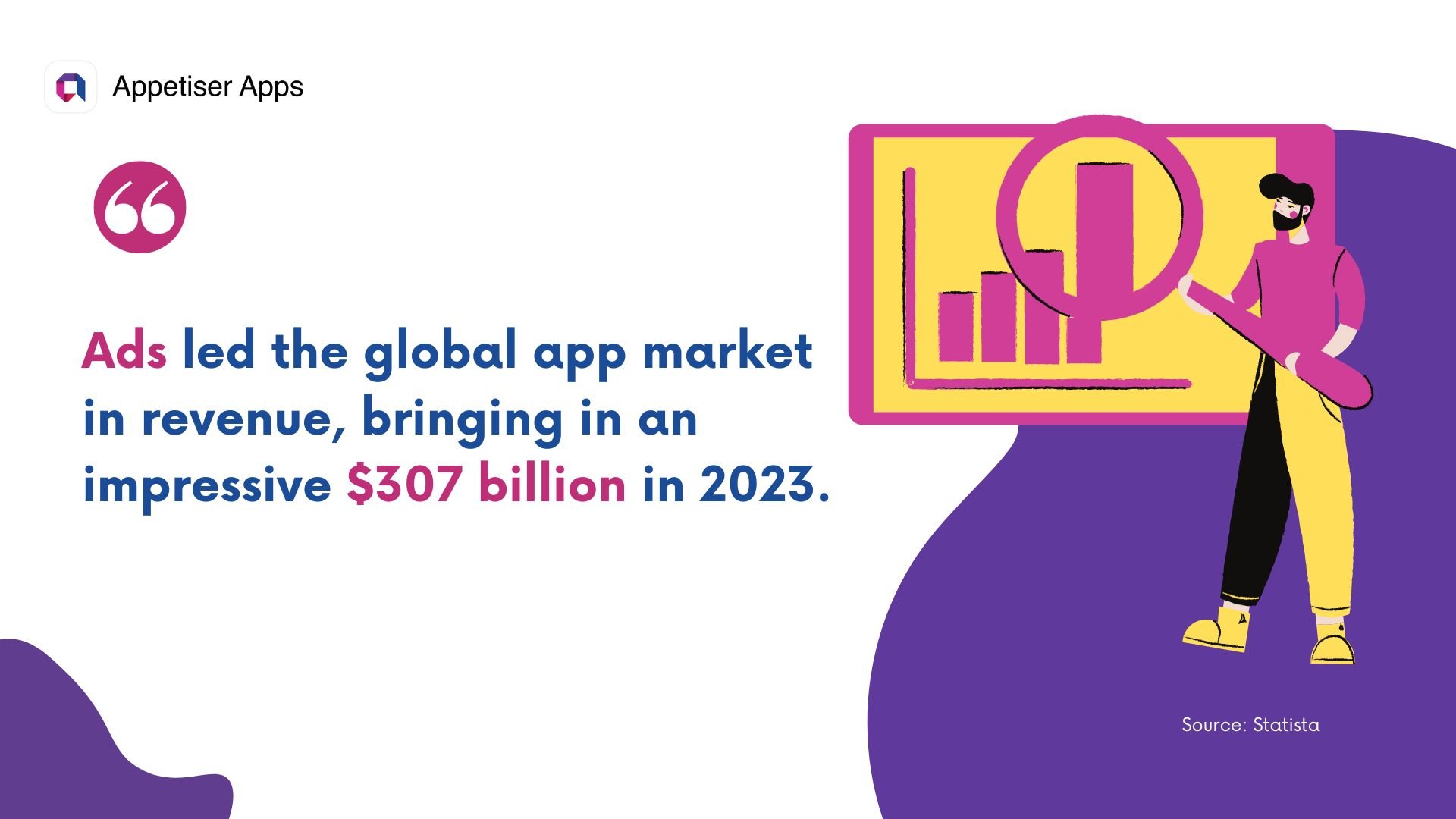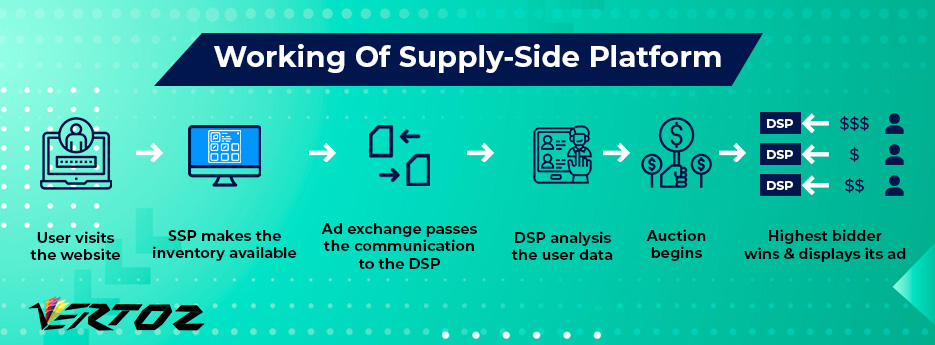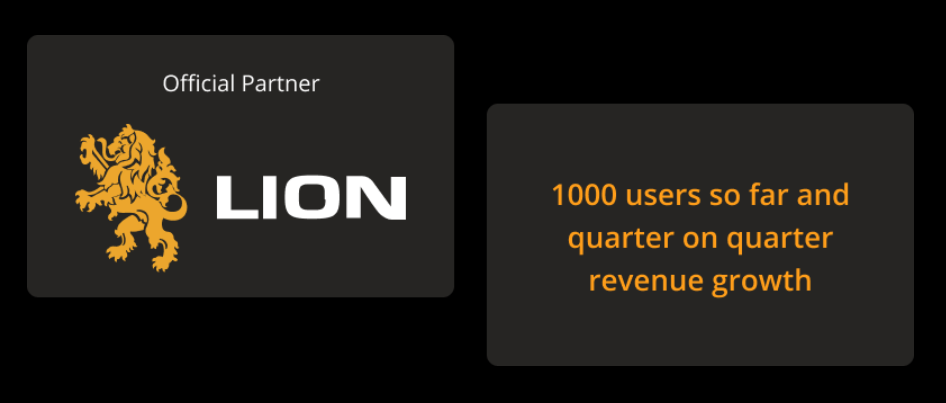How to Get Ads for Your App and Monetize Effectively

I remember attending a vibrant tech innovator festival a few years ago.
It was a high-energy event buzzing with hundreds of tech enthusiasts, entrepreneurs, and industry leaders. The venue was packed, the excitement was palpable, and the booths were overflowing with visitors.
Clearly, the event attracted a massive crowd. However, during a casual chat with one of the exhibitors, I learned something surprising—they were struggling to convert that high foot traffic into significant sales.
This situation mirrors the challenge many app publishers face when trying to monetize an app.
You may have an application that’s drawing in users, but converting that engagement into revenue can be tricky. You must actively find ways to make money from your platform, even if it’s a free app.
One effective method is to attract mobile advertisers. How effective?
In 2023, ads took the lead in the global app market revenue— pulling in a whopping $307 billion.

So, how can you tap into this lucrative opportunity?
In this blog, I’ll share effective strategies on how to get ads for your app to increase your revenue. Read on to discover how you can turn your app’s potential into a thriving income stream!
How to find advertisers for your app: 8 proven ways
1. Direct deals: Premium ads, secured directly
Direct deals are the top choice for mobile app publishers who want more control over how they monetize their apps. Instead of relying on middlemen, you directly negotiate with companies that are a perfect fit for your app’s audience. This method often yields higher revenues and more control over ad content.
This approach can be time-consuming, but the payoff is worth it. You have to identify potential advertisers, pitch your app, negotiate terms, and build strong relationships. Each step requires significant effort and follow-up, but securing direct deals often results in higher revenue and better ad alignment for your app.
Take Calm, for example.

The meditation and relaxation app has become a household name with millions of users seeking mindfulness and stress relief. Instead of relying solely on traditional advertising networks, Calm pursued direct deals with brands aligned with their wellness-focused audience.
Calm partnered with Ogilvy to create the Mindful Manager Program, enhancing employee well-being with guided meditations and sleep aids. They also partnered with Fitbit, giving its premium app users access to select Calm sessions.

🚀Pro tip: To find potential advertisers, attend industry networking events, conferences, and trade shows where you can connect with companies that align with your app’s audience. Having a Uniqode digital business card ready on your phone makes sharing your app’s key metrics and contact information seamless during these networking opportunities. You can also leverage online platforms like LinkedIn to research and reach out to decision-makers.
Reach out with a compelling pitch that highlights how advertising on your app can benefit them.
Tailor your pitch to show how advertising on your app will give them a direct line to their target audience. Have confidence in what you bring to the table. You’re not just selling ad space—you’re selling an opportunity for them to tap into a highly engaged and specific user base.
2. Ad networks: Ad brokers in action
Ad networks are the middlemen in the mobile advertising industry. They connect you with a range of advertisers looking to place ads on apps like yours. Popular ad networks include Google AdMob, Unity Ads, and Facebook Audience Network.
Think of ad networks as stock brokers for ads. They aggregate ad inventory from multiple publishers and pool together demand from various advertisers. They also provide targeting and analytics tools to help you optimize your ad revenue. This makes it easier for publishers to fill their ad space and for advertisers to reach their target audiences.
🚀Pro tip: Use your network’s targeting features to create audience segments based on interests and behaviors. This helps you offer more relevant ad placements to attract more advertisers.
2. Ad waterfalls: The highest-paying ads get priority
Ad waterfalls help you earn more by showing ads from networks that pay the most first. Picture a cascading waterfall where the highest bidder’s ad is displayed first, followed by the next highest, and so on.
Here’s how it works:
- You set up a list of ad networks based on how much they pay. The highest-paying network is at the top.
- When there’s an ad spot, the system first tries to fill it with the top network’s ad. If that network doesn’t have an ad ready, it moves to the next one on the list.
- This way, you get the highest possible payment for each ad spot without extra work.
Unlike ad exchanges, which let all networks bid at once, ad waterfalls use a fixed order to ensure higher-paying ads get shown first.

🚀 Pro Tip: For higher earnings, track each network’s performance and adjust your waterfall setup to focus on the most profitable ones.
3. Ad exchanges: Real-time bidding, top dollar
Another method that involves bidding is an ad exchange. These platforms let multiple networks bid on your ad space at the same time, which drives up prices and helps you earn more. The real-time competition and transparency about ad value help you get the highest possible price for each ad impression.
Ad exchanges also complement ad networks by providing a platform for buying and selling ad space—much like a stock exchange but for ads. If ad networks are brokers, ad exchanges are the marketplaces.
For example, once a network pools inventory from various publishers, it can use an ad exchange to facilitate competitive bidding among advertisers. This helps ensure that each ad slot gets the best possible price.
Here’s a video explaining how ad networks and ad exchanges differ and work together:
🚀Pro tip: Regularly update your ad inventory and targeting settings to keep your ad space appealing to a variety of bidders. This ensures you get the best possible revenue from your ad space.
4. Programmatic ads: Automated ad precision
Programmatic advertising uses smart technology to automate ad buying, making it easy for you to find and secure the best deals for your app’s ad space. It helps you target advertisers more precisely, leading to better engagement and higher earnings.
With programmatic ads, you can use data to show advertisers how your audience matches their target market. This helps you make a compelling case for why they should choose your app for their ads.
eMarketer projects that programmatic ad spending in the U.S. will hit $157.35 billion in 2024, highlighting the effectiveness of this approach.
I found a short video explaining how programmatic advertising works. Watch it to learn how you can leverage it to attract top-tier advertisers.
🚀Pro tip: Use data analytics tools to showcase how your audience matches advertisers’ target markets. This personalized insight is like offering them a gold mine, boosting your ad space’s appeal and your revenue.
5. Supply-Side Platforms (SSPs): Automated marketplace for optimizing ad sales
SSPs let you sell ad space automatically, similar to listing your property on Airbnb. They simplify ad management by connecting you with various ad exchanges and networks (you’ll learn more about this later). This means you get more bids and better prices for your ad space without having to handle it all yourself.
Popular SSPs include PubMatic, OpenX, and Google Ad Manager.

Source: Vertoz
🚀Pro tip: Regularly check and adjust your targeting and pricing settings on SSPs. Try out different ad formats and watch performance reports to spot trends and make smart decisions that boost your ad sales.
7. Hybrid solutions: Mix, match, and maximize ad revenue
Why settle for just one ad monetization method when you can blend multiple approaches for better results? Combining different methods lets you cover all your bases and tap into various revenue streams.
Relying on a single strategy is like trying to win a race with just one wheel on your bike. Hybrid solutions—mixing direct deals, ad networks, and programmatic ads—give you the flexibility to adapt and maximize your revenue potential. This approach reduces risk and opens up new opportunities for higher returns.
🚀Pro tip: Track the performance of each app monetization strategy separately. This way, you can see which makes you the most money and adjust your strategy accordingly. It’s a simple way to focus on what works best.
How to attract advertisers into your app: 4 best practices
So now you know how and where to find app advertisers. But how do you convince them to trust your vision, reach into their pockets, and get on board?
Let’s look at the best practices that have worked for many of our partners:
1. Build a strong user base and engagement metrics
Advertisers are like potential investors—they want to see a solid return on their investment. The stronger your user base and engagement metrics, the more attractive your app becomes.
Action steps:
1. Focus on growth
- Invest in content marketing, social media, and partnerships to increase your user base and engagement. More users mean more ad opportunities.
2. Track metrics
- Use mobile analytics tools to monitor user behavior. Highlight metrics like session length and retention rates to show advertiser appeal.
3. Enhance user experience
- Continuously improve your app’s performance based on user feedback. Happy users stay longer, boosting your engagement stats.
- Regularly update with fresh content to keep users interested. Active users make your app more attractive to advertisers.
A great example of this in action is the MUCUDU app.

After launching their minimum viable product (MVP), the MUCUDU team focused on iterating based on user feedback. They used insights from their initial users to refine features and enhance the app’s overall experience.
This approach helped them secure a partnership with LION, one of Australia’s largest beverage companies, demonstrating how enhancing user experience can attract high-profile advertisers.

Curious about how they made it happen? Check out MUCUDU’S case study to see the full story.
2. Showcase your app’s value proposition
Once you’ve built a solid user base, the next step should be to flaunt it along with the other factors that make your app valuable.
What makes your app stand out? Why is your audience perfect for their brand?
Just as you’d want to showcase your app’s features and benefits to potential users, you need to present your app’s value to advertisers. Advertisers want to know why they should invest their money with you.
Action steps:
1. Create a media kit
- Include details about your user base, app engagement metrics, and market reach to demonstrate your app’s potential.
- Highlight key stats like daily active users (DAUs), monthly active users (MAUs), and demographics to show advertiser appeal.
- Use visuals and infographics to make data engaging and easy to digest.
- Share your app’s journey and milestones to add a personal touch and relatability.
If you want to learn how to showcase your app’s success story, check out how we do it for our clients in our portfolio.
2. Leverage data
- Create comprehensive reports on user behavior, demographics, and engagement to build credibility.
- Break down performance data by ad types or industries to attract advertisers from various niches.
3. Prepare case studies
- Share success stories that demonstrate how advertising on your app drives results, adding credibility.
- Include metrics and testimonials from previous advertisers to showcase tangible benefits and build trust.
4. Craft a compelling pitch
- Create a standout pitch deck that visually showcases your app’s selling points.
- Summarize why advertisers should choose your app to make your case clear and strong.
- Tailor the pitch to each advertiser to show you understand their brand and audience.
- Highlight unique benefits, like high engagement rates and specific demographics, to make your app stand out.
3. Develop attractive advertising options
Advertisers have different needs and budgets, and providing a variety of advertising options makes your app a more attractive choice.
The more flexible you are, the better you can match your ad spaces to what brands are looking for, which helps you secure more deals.
Action steps:
1. Diversify your ad formats
- Provide a variety of options like banner ads, interstitial ads, and native ads to meet various advertiser goals.
- Introduce interactive in-app ad formats like quizzes or polls to boost engagement rates,
I wrote another blog discussing the different types of mobile advertising in-depth. I encourage you to check it out.
2. Create premium ad placements
- Consider exclusive placements or featured spots for premium advertisers. These spots allow higher visibility and command better rates.
3. Conduct A/B testing
- Test different ad formats or placements to figure out which performs best. Share the insights with advertisers to show that you optimize ad strategies for maximum impact.
4. Customize ad deals
When you find interested advertisers, negotiate deals that align with both parties’ goals. Customize ad packages to fit their needs while ensuring they enhance your app’s user experience. This approach helps build partnerships that benefit everyone involved.
To negotiate effectively, you must understand your app’s value and what you offer. Think of this step like a friendly poker game: know your hand (app’s strengths) and play it smart to secure the best deal. Aim for an arrangement that leaves both parties satisfied and enhances the overall experience for your app’s users.
Action steps:
Outline deliverables and outcomes to prevent surprises and build trust.
Specify where ads will appear within your mobile app to avoid any confusion.
Determine which performance metrics will be tracked and reported.
Establish clear timelines for campaign launch, duration, and reviews.
Agree on how and when updates and reports will be communicated.
Set pricing models to align with budget and goals.
Establish payment schedules to avoid delays.
Discuss and agree on any exclusivity clauses to ensure no conflicts of interest.
Provide ongoing assistance to optimize ad performance and maintain positive relationships.
How to put ads to your app: A step-by-step guide
Now that you know how to get advertisers on board, let’s talk about integrating ads into your app.
- Choose Your Ad Network. Select an ad network that aligns with your app’s target audience.
- Integrate SDKs. Download and integrate the Software Development Kits (SDKs) provided by your chosen ad network.
- Set Ad Placement Decide where in your app you want to display ads – banner ads, interstitial ads, rewarded videos, etc.
- Test Ads. Before going live, test the ads to ensure they don’t disrupt the user experience.
- Monitor Performance. Use analytics tools to track ad performance and make necessary adjustments.
🚀Pro tip: Always prioritize user experience. Too many ads can drive users away, but well-placed ads can enhance their experience and your revenue.
People Also Ask
How do I get ads on my app?
Getting ads on your app is easier than you might think. Most developers start by integrating with an ad network like Google AdMob, Unity Ads, or AppLovin. These platforms provide SDKs (software development kits) that you add to your app, and they handle showing ads, tracking impressions, and paying you. You choose the ad types—like banners, interstitials, or rewarded video—and the network does the heavy lifting.
How much can I make from ads in my app?
It really depends on your app’s user base, the region your users are in, and how often ads are shown. On average, earnings range from $0.01 to $0.50 per ad view, and $1 to $10+ per 1,000 impressions (CPM). Rewarded video ads often pay more. Games and utility apps with high engagement usually perform best.
Is it possible to make $100 a day just from ads?
Yes, it’s possible—but you’ll need a decent number of active users. To earn $100/day, for example, you’d typically need around 10,000–50,000 daily active users, depending on your ad strategy and CPM rates. It doesn’t happen overnight, but with a well-designed app and solid marketing, it’s definitely achievable.
How do I get paid for the ads in my app?
Once you’ve set up with an ad network like AdMob, you’ll receive monthly payments directly to your bank or PayPal, usually once you reach a minimum payout threshold (like $100). The network handles the billing and payments—you just need to focus on driving traffic and user engagement.
How can I get more ads for my app?
To get more ads showing in your app, you’ll want to make your app more attractive to advertisers. Start by increasing user engagement—more active users mean more ad impressions. Next, consider joining multiple ad networks or using a mediation platform like AdMob Mediation, IronSource, or MAX by AppLovin. These tools pull ads from several sources, so you’re not relying on just one network to fill your ad space. Also, make sure your app follows ad policies and offers a clean, smooth user experience—networks reward apps that keep users happy.
Become a magnet for advertisers
Securing advertisers for your app boils down to a few essential strategies: knowing your app’s worth, offering diverse ad options, and making a strong pitch.
But remember, it all starts with a high-quality app. An outstanding app naturally attracts more advertisers and opens up greater revenue opportunities. Take it from mobile apps like Youfoodz, Vello, and Roamni. All have seen substantial growth and revenue boosts by investing in top-notch app development services.
Want to ensure your app is truly exceptional and ready to captivate advertisers? Consider our holistic approach to app development. Our exclusive product accelerator program fast-tracks development, sharpens your app’s features, and primes it for premium ad opportunities.
Call us today and let’s create an app that’s a future advertiser magnet!

Jane Eslabra has 14+ years of experience producing content across traditional and digital platforms. She channels her strong passion for fostering tech startup growth through knowledge sharing.


